We take a look at the power of personalization in retail. How it helps you deliver unique customer experiences and a boost to retail sales
Great customer experience is about putting the customer at the centre of everything you do. It’s about giving them what they want quickly and making them feel special in the process.
But when you’re faced with thousands of customers, it can be hard to put your best intentions into practice. Personalisation changes this.
Does personalization in retail matter?
Personalization tends to be seen as a buzzword. People tell you it’s important without sharing the facts. But there’s hard proof that personalization counts when it comes to sales.
Remember the ‘Share a Coke’ campaign with people’s names plastered across the packaging? This personal approach was credited with growing Coke’s sales for the first time in 10 years.
The research shows Coke’s experience isn’t an isolated one. 75% of consumers are more likely to buy products from retailers that use their name, provide personal recommendations and know their preferences, according to a study by Accenture.
Research at Pure360 found that half of consumers are likely to engage with retailers that send relevant personalized offers.
Then, of course, there are the risks of not personalizing. Research by Salesforce revealed that over 52% of consumers would switch away from brands that don’t personalize communications.
Retailers’ resistance to personalization
Despite the evidence, retailers still seem reluctant to invest in personalization.
In fact a recent survey by Retail Week revealed only 14% of retailers think personalization is essential. Shockingly it’s all down to a simple knowledge gap between retailers and their ability to make full use of the technology available to them.
The general perception is that personalization is difficult to implement and even more difficult to get right.
Retailers now have multiple customer touchpoints to manage: eCommerce, social, CRM, email, offline marketing, and of course, brick-and-mortar.
Today’s omnichannel landscape gives even more reason to implement personalization. These multiple touchpoints all play a part in the modern customer journey. Personalization helps make sense of this complexity and translates it into coherent and relevant experiences for customers.
The technologies available today let you bring all the data together in one single customer view. They let you join the dots between your data and see how customers are interacting with your different channels and campaigns.
Bringing data to life
Having the data is one thing but how do you use it to create personalized experiences in retail?
Well it’s easier than you might think. Here are just a few examples of how you can deliver unique customer experiences which increase sales:
Personalized email content
Personalization in retail has gone way beyond simply sticking the customer’s name in the email. If you really want to strike up a relationship you’ve got to show that you really know them. And you don’t have to stalk them to do this.
We love the personalized approach to Boden’s emails. It goes to show how personalization can help enhance brand affinity.
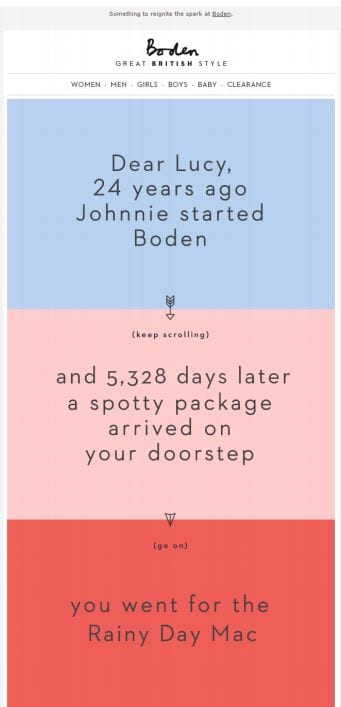
Personalized automations
Content is only half the battle in retail personalization. Timing is key to being relevant.
Landing in the inbox at a time that’s relevant to the recipient is vital when trying to implement automations.
One of the most common examples of a personalized automation is the basket abandonment email. However many retailers are still not implementing this must-have automation.
Research by Barclaycard revealed that UK consumers leave £18 billion worth of products in online baskets every year. What’s more, 59% of retailers are unaware of their own abandonment rate.
Basket abandonment emails are an obvious quick win for any retailer looking to grow eCommerce revenue. We see it first hand with our own customers—they recover 12% of revenue lost to basket abandonment when implementing our technology.
Debenhams show that timely abandonment emails are key to making the customer take a second look. They are triggered shortly after the individual has visited the site and their content and timing is unique to each customer’s actions.
Personalized recommendations
Product recommendations are fairly common on most eCommerce sites. However, recommendation engines have come on leaps and bounds in recent years.
This is thanks to machine learning which analyses real-time behaviors, previous transactions and recent browsing behavior to ensure the right products are recommended to the right person.
Machine learning also draws upon the wisdom of the crowd to determine recommendations. It looks at the behavior shown by an individual and compares it to actions taken by people who showed similar behaviors.
The people like you bought…’ and ‘items you might like..’ tactic works wonders for Amazon (and now so many other online retailers). These personal recommendations are what reportedly generated 35% of Amazon’s income in the not so distant past!
Personalized cross-selling and upselling
Upselling and cross-selling are some of the best opportunities you have to deliver personalization that increases revenue. After all you know what the customer has browsed or purchased, so it’s easy to present similar or complementary items to their potential purchase.
We really like the way ASOS invite browsers on their website to ‘complete the look’ with additional items. It’s a great way to build the value of the customer’s potential order with relevant suggestions.
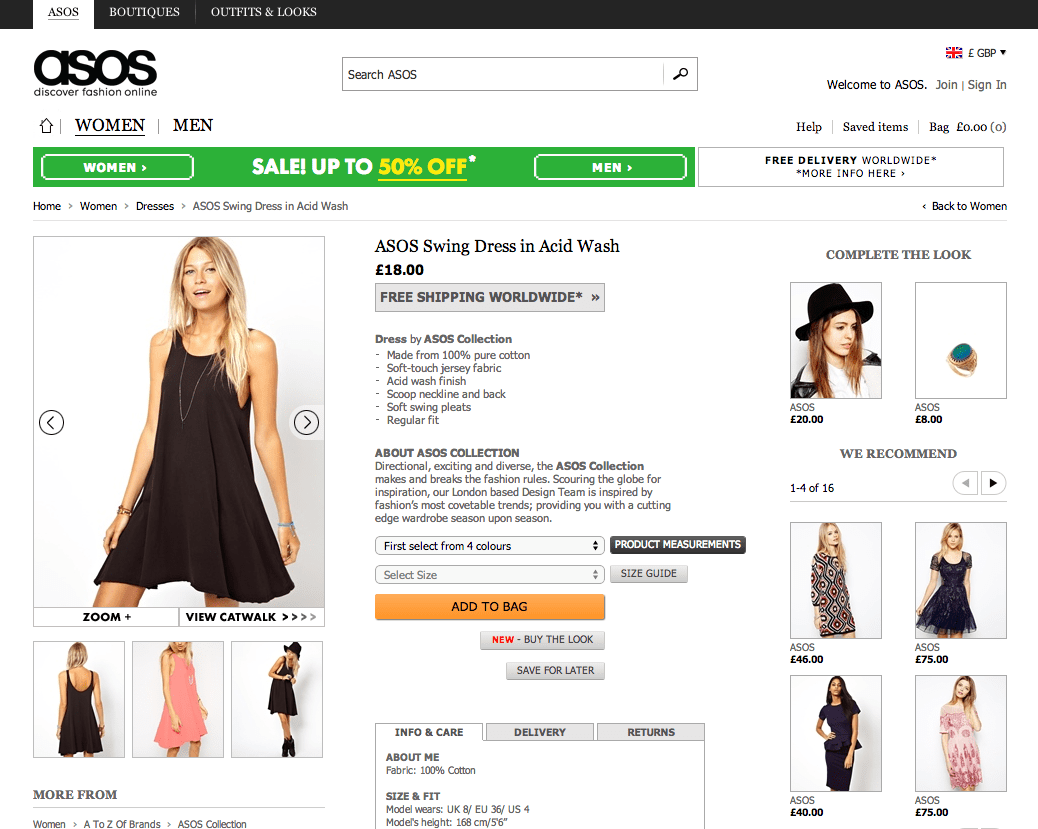
Personalized customer journeys
Creating a robust series of personalized lifecycle automations helps build up a connection with the customer. And because the information is drip-fed, it appears like a more natural and personal conversation.
Saks Fifth Avenue shows us that you don’t have to throw everything into one welcome email. They space out the messages and tailor the send times to make it appear more like a one-to-one dialogue.
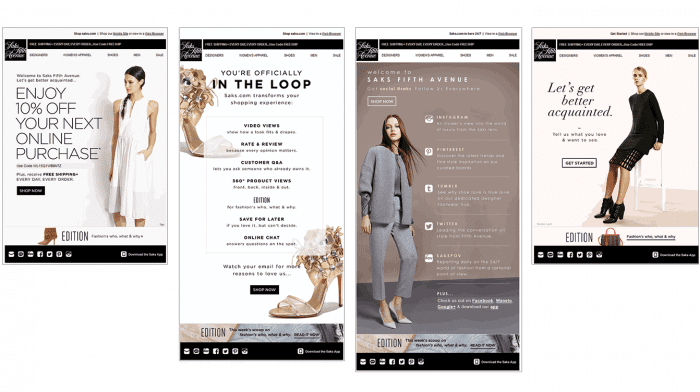
Contextual personalization
Personalization in retail doesn’t even need to be about customer behavior. You can use contextual data such as their location or the weather (or both!) to personalize your website experience.
We really love how Very.co.uk incorporates real-time weather updates into their homepage. They’re specific to the browser’s location and make the products they are promoting much more relevant.
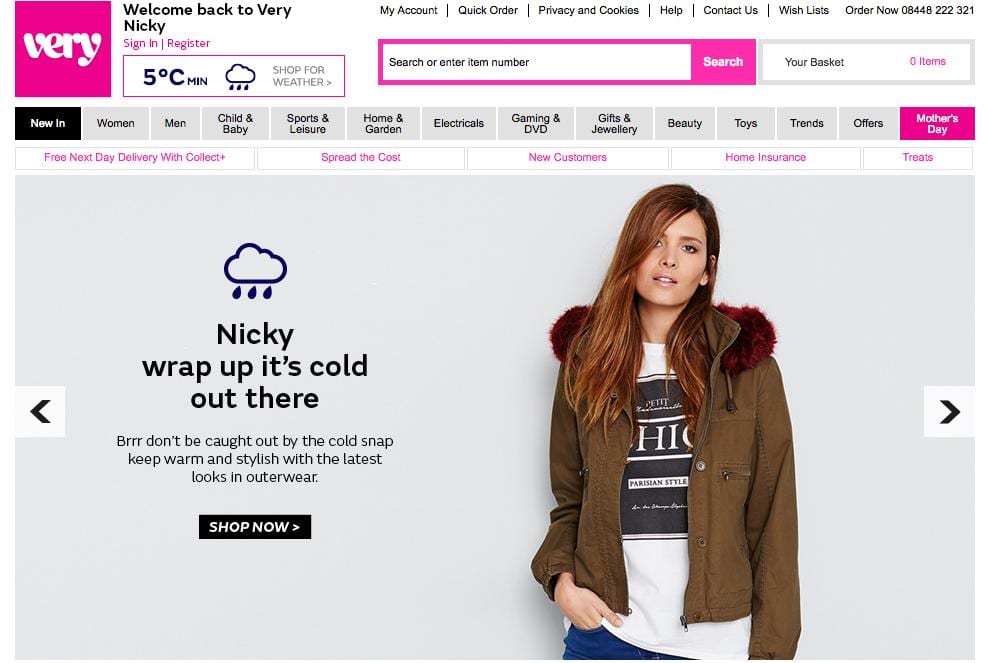
Personalized promotions
Don’t just focus on product – look at your customer’s spending habits too. Look at what other brands they like or the amount they tend to spend.
Birchbox is very upfront about its use of machine learning technology to generate personalized promotions. It’s a great way to ensure your promotions always appeal.
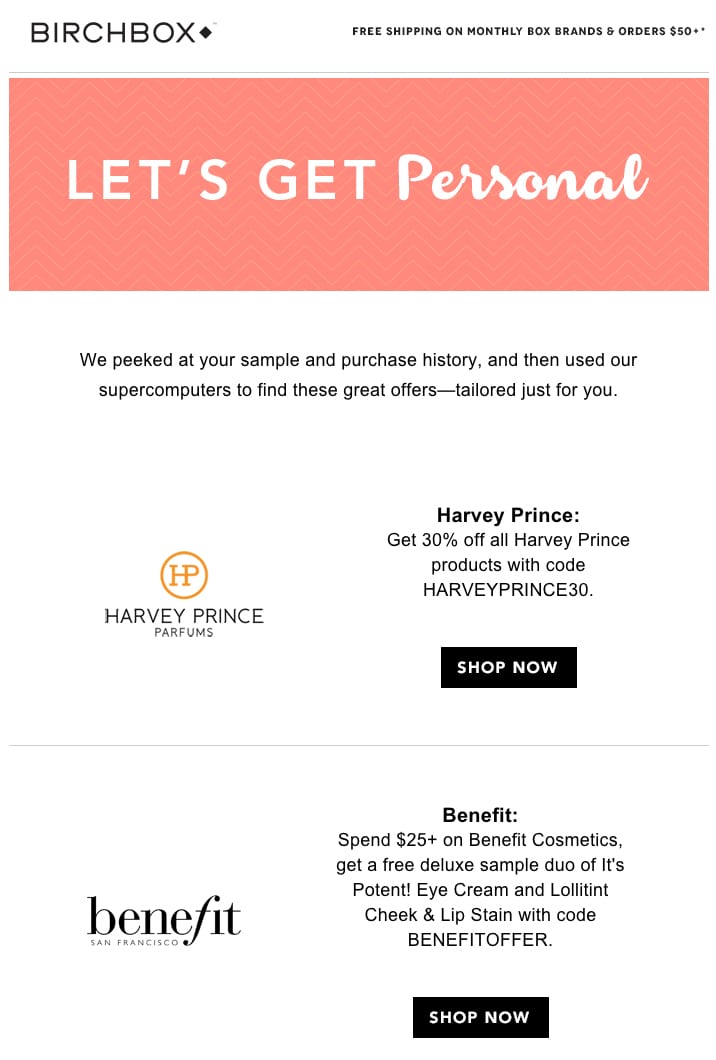
Personalized prompts
It’s easy to use what you know about the customer to encourage them to choose your brand above your competitors. If you sell consumable products like cosmetics or health supplements, replenishment emails are a must.
A timely email that makes it easy to buy again is a win-win between you and your customer.
MyProtein shows how you can keep a customer coming back by offering convenience with replenishment emails.
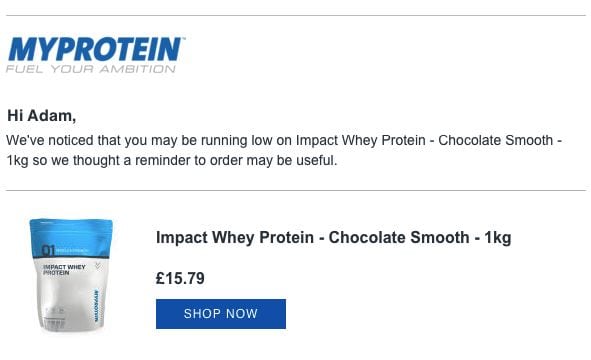
The business case for personalization
There are many statistics that support the need for personalization from a business perspective.
Perhaps the most compelling is that according to Econsultancy, 93 percent of companies see an uplift in conversion rates using personalization. There aren’t many marketing initiatives that are likely to see success 93% percent of the time they’re implemented.
At Pure360, we believe that the strongest business case for personalization is that consumers are demanding it.
Consumers places huge value on their own time. By delivering the most personalized content people can find what they want, faster. You’re making their lives easier and increasing the chances they’ll come to you before the competition. It’s the very reason that retailers who deliver a personalized experience reportedly grow two-to-three times faster than retailers who don’t.
When investing in personalization, you’re investing in a better customer experience. It just so happens that more revenue is a by-product of that.
Takeaway
When it comes to personalization there’s nothing holding retailers back. The technology, insight and ability to pick off tactics one stage at a time means it’s within everyone’s reach (and budget).
So if people ask you what your big win for 2018 will be then tell them it’s personalization. Used well it’s the secret to standing out, beating off the competition and achieving growth.
Interested in learning more? Read Pure360’s best practice guide to website personalization.